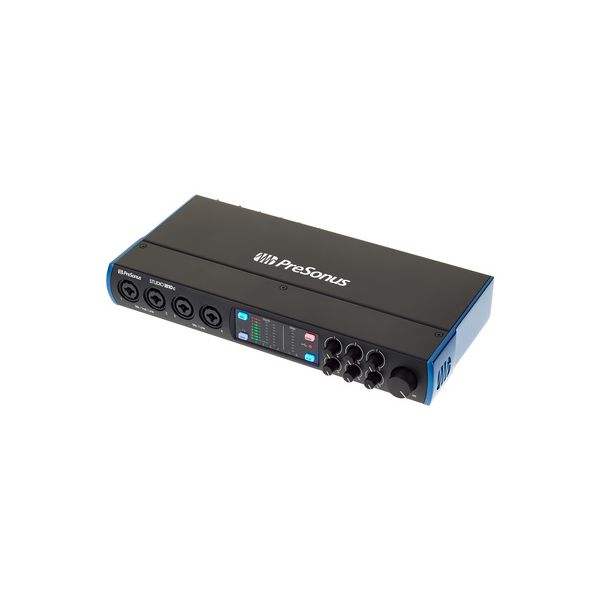Presonus Studio 1810c B-Stock
B-Stock with full warranty
Slight traces of use
USB-C 18 x 8 Audio Interface
- 24-Bit / 192 kHz
- 2 Mic / Line / Inst front-panel combo inputs: XLR / jack
- 2 Mic / Line front-panel combo inputs: XLR / jack
- 48 V Phantom power
- 4 TRS line inputs on the back panel
- ADAT optical input: 8 Channel / 48 kHz, 4 Channel / 96 kHz
- 2 TRS outputs with level control and mute button
- DC-coupled line outputs allow the sending of CV / gate signals from a DAW
- 4 TRS jack line outputs
- 2 Headphone outputs with A/B circuit on headphone output 1
- S/PDIF and MIDI input/outputs
- Flexible routing
- Latency-free monitoring
- Powered via external power supply (included)
- Compatible with the following: from Windows 7, Mac OSX 10.11 or newer, and iPads (requires optional Apple iPad Lightning to USB camera adapter)
- Includes USB-C to USB-C, a USB-C to USB-A cable, as well as Studio One Artist
Compact DSP audio interface
The Presonus Studio 1810c is an audio interface with a USB-C connection and an integrated DSP processor that can be used to create three zero-latency monitor mixes and packs an impressive number of connections into its compact frame: Four XMAX preamps (the first two of which can also process high-impedance instrument signals) and four line inputs as well as SPDIF, ADAT, and MIDI I/O interfaces. The Studio 1810c additionally features two headphone outputs, four line outputs, and a main output for connecting studio monitors, and to allow users to get started right away, the scope of delivery includes a power supply, two USB cables, and the Studio One Artist software.

:format(jpeg))
Plug-and-play at its finest
The Presonus Studio 1810c is connected to the user's computer via the USB interface and can then record up to 18 channels (eight analogue and ten digital) simultaneously. The monitoring volume can be adjusted using the main rotary control on the interface's front panel, and the large LED meters provide a useful visual display of the input gain levels for the four mic signals. Instead of the four line inputs on the rear of the Studio 1810c being regulated by a gain control, their signal is sent directly to the AD converter in order to prevent any colouration of the sound, and the UC Surface software, which is compatible with Mac and Windows operating systems as well as both iOS and Android end devices, allows the interface to be controlled remotely.
:format(jpeg))
Ideal for home recording on a budget
The Presonus 1810c bridges the gap between the company's affordable two-channel interfaces and higher-priced (professional) rack interfaces, which makes it the perfect choice for budget-conscious home recording artists who want to get the best possible value for money in terms of features and sound quality. Incidentally, the use of the word "Studio" in the 1810c's name is more than just a marketing ploy, as evidenced by the fact that the user can create three different zero-latency monitor mixes with 24-bit conversion and a sampling rate of up to 192kHz and thus even record small ensembles. A feature worthy of special mention is that the Presonus Studio 1810c features four of the same excellent-sounding XMAX-L microphone preamps as featured in the company's high-end digital consoles.
:format(jpeg))
About Presonus
Presonus is a US company founded in 1995 by Jim Odom and Brian Smith in Baton Rouge, Lousiana. The firm designs hardware and software at both professional and more affordable levels for musicians and producers. Presonus first made a splash in the mid-1990s with the DCP8, an eight-channel analogue compressor/limiter/gate with fader and mute automation that could be digitally controlled by MIDI. In the early 2000s followed a series of microphone amplifiers and the first audio interfaces for the then-emerging home studio scene. Today, the company's product range includes audio interfaces, microphone preamps, digital mixing consoles, and studio monitors as well as the established DAW software Studio One.
A creative tool for the studio and on the go
Whether it is used as a stationary interface for simultaneously recording small bands in the studio or for live applications "on the go", the Presonus Studio 1810c will always cut a fine figure. Singer-songwriters in particular will appreciate the interface's compact dimensions, which make it extremely easy to take with them and make recordings of their live performances or record their ideas as they happen - which they can then enhance with virtual instruments and effects via the Studio One Artist software to create complete CD productions. What is more, the Presonus Studio 1810c's ability to create three separate monitor mixes also makes it an interesting proposition for DJs, who can use the main output to run a PA system and cue their tracks via the headphone outputs.
:format(jpeg))
-
Presonus USB Audio Interfaces at a glance
-
Display USB Audio Interfaces from $ 250 - $ 350
-
Go to product group USB Audio Interfaces
-
Go to product group Audio Interfaces
-
Go to product group Studio and Recording Equipment
-
Show manufacturer details for Presonus
-
Presonus Studio and Recording Equipment at a glance









